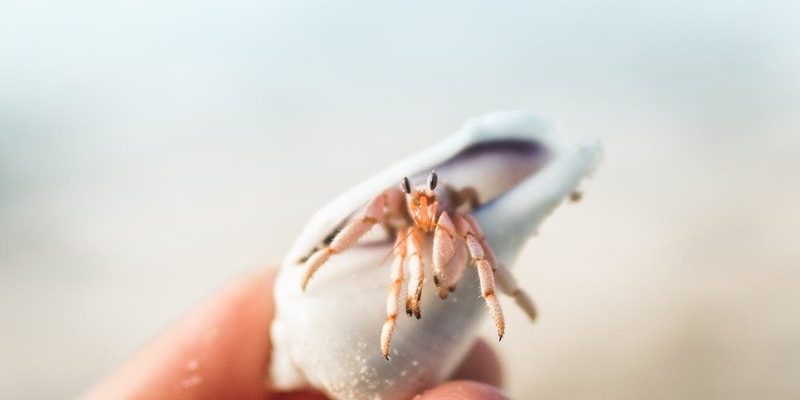
Let me explain. Hermit crabs are known for their quirky behaviors and unique personalities, but they do have specific needs and preferences that you should understand before diving into interactions. Just like a shy person might need a little time to open up, hermit crabs have their own comfort zones. In this article, we’ll explore how to interact with these delightful creatures safely and respectfully, ensuring that both you and your little friend are happy.
Understanding Hermit Crab Behavior
Hermit crabs are social animals, but they aren’t like dogs that thrive on constant attention. Instead, they enjoy the company of their own kind. In the wild, you’ll often find them in groups, and they use their shells not just for protection but also to communicate. If you’re thinking about getting a hermit crab, it’s best to have at least a couple so they can interact with each other.
*You might be wondering what to expect when you first meet a hermit crab.* If they’re shy, they could retreat into their shells when startled. This is totally normal behavior! To build a relationship, try spending time near their habitat without making sudden movements. It’s like being in a coffee shop: sometimes, just sitting quietly next to someone can lead to a nice chat later.
When interacting with hermit crabs, observe their body language. If they extend their antennae and explore their environment, they’re likely feeling curious. But if they pull into their shell or hide, it’s a clear sign they need some space. Just remember, building trust takes time, so patience is key here.
Creating a Safe Environment
For successful interactions, creating a safe and comfortable habitat is crucial. Hermit crabs thrive in a well-maintained environment, as it directly affects their mood and behavior. Here are a few things you should consider:
- Temperature and Humidity: Hermit crabs require a warm environment, ideally between 75°F to 85°F, with humidity levels around 70-80%. A tank with a heater and a humidity gauge will keep them cozy.
- Substrate: Use a suitable substrate, such as sand or coconut fiber. This allows them to burrow, which is essential for their well-being.
- Hiding Spots: Provide plenty of hiding spots using logs, rocks, or even commercially available caves. This gives them a chance to retreat when they need some alone time.
By ensuring their habitat is up to snuff, you’re setting the stage for a healthier interaction. Think of it like preparing a cozy room for a guest—if they feel at home, they’ll be more relaxed and open to your company.
How to Handle a Hermit Crab Safely
When it comes time to directly interact with your hermit crab, you want to do it safely. Here are some steps to keep in mind:
1. Wash Your Hands: Before handling your hermit crab, wash your hands thoroughly. This helps eliminate any harmful substances that could harm them.
2. Approach Slowly: When you’re ready to pick them up, approach slowly and gently slide your hand under their shell. Think of it like giving a gentle nudge rather than a quick grab.
3. Keep It Low: Always handle them close to a soft surface, like a pillow or a carpet. If they decide to jump or fall, this soft landing can help prevent injuries.
4. Limit Handling Time: Keep handling sessions short, especially at first. This gives them the chance to get used to your presence without feeling overwhelmed.
Remember, hermit crabs shouldn’t be handled too often. Too much interaction can stress them out. Aim for short sessions and let them explore their environment on their own terms.
Signs of Stress in Hermit Crabs
Identifying when your hermit crab is stressed is essential for their well-being. Some signs may include:
- Retreating into their Shell: If they spend too much time in their shell and are hard to coax out, they might be feeling anxious.
- Flicking Antennae: If your hermit crab is flicking its antennae or moving erratically, they may be overwhelmed.
- Color Changes: A sudden change in color can indicate stress or health issues. Pay attention to how they look regularly.
If you notice any of these signs, give your hermit crab some space. It’s perfectly fine to let them chill out in their habitat. Honestly, respecting their boundaries will enhance the bond you share.
Feeding and Interacting
Another great way to bond with your hermit crab is through feeding. Offering food can create a positive experience for both you and your crab. Here’s how you can make feeding time special:
1. Offer a Variety of Foods: Hermit crabs are omnivores, so they enjoy a balanced diet. Try providing a mix of commercial crab food, fresh fruits, and vegetables. They especially love things like apples, leafy greens, and even shrimp.
2. Hand-Feeding: If you’re feeling adventurous, try hand-feeding small pieces of food. This can create a sense of trust as they learn that you bring yummy treats.
3. Observe Their Preferences: Take note of what they favor the most. This not only helps in keeping them happy but also can make for interesting interactions.
Imagine sharing a meal with a friend. You leave happy, and your crab will too!
Interacting with hermit crabs can be a delightful experience if done safely and respectfully. These little creatures, with their unique shells and quirky habits, can bring a lot of joy to your life. The key is to create a welcoming environment, be patient, and recognize their needs and feelings.
In the end, a successful interaction with your hermit crab is about mutual respect. By understanding their behavior and providing a safe space, you can create a lasting bond. So, whether you have a hermit crab at home or just enjoy watching them at the beach, remember that these little guys deserve a bit of TLC!

